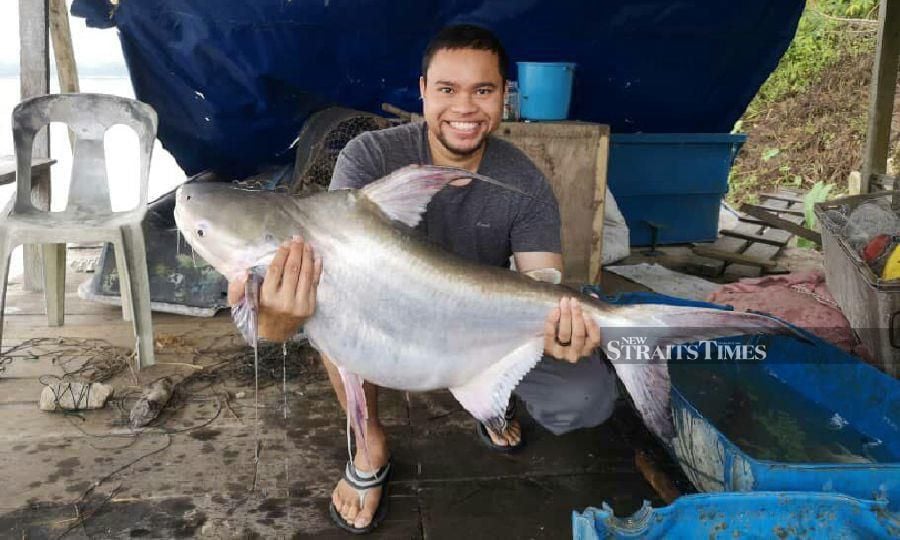Articles / Newsletter

IPOH: An ecological disaster is happening in major rivers in the country with the invasion of alien fishes from the mighty Amazon river of Brazil and Chao Phraya in Thailand.
Sungai Pahang is now home for the red tail catfish (Hemibagrus wyckoides) of the Mekong river system, and Sungai Perak the gargantuan Chao Praya high fin catfish.
Sungai Kinta is no exception and the invasion is now a serious issue with local fishermen who used to land local species such as tengalan (Puntius bulu), krai (Hypsibarbus sp.), temoleh (Probarbus jullieni), kelulang (Hemibagrus wyckii) and baung (Hemibagrus capitulum).
But in less than 20 years, fishermen in Sungai Perak have landed invasive species such as the giant Chao Praya high fin catfish (Pangasius sanitwongsei), leekoh (Cyprinus carpio), gar fish, jade perch, black carp, silver carp (Hypophthalmichthys molitrix), katla carp (Catla catla) and African catfish (Clarias gariepinus).
The names of these fishes itself indicated that they are not local and most of these species are giants in the fish world known to devour any smaller fish that cross their path.
Local fish species will not stand a chance against these giants, including the toman (Channa micropeltes) and juvenile tapah (Wilago catfish).
Muhammad Shazwan Pakharudin, 28, an ornamental fish trader from Malim Nawar, Perak said he is aghast with the rate these invasive fishes propagated.
"The floods only make matter worse as these fishes may migrate upstream to spawn, but what is more worrying is they could invade other smaller rivers when the flood subsided," he said in an interview with the New Straits Times.
Shazwan said in Perak, some aquaculturists raised these invasive fish species in cages at abandoned mines.
"During floods these fishes escape from the mining pools and swim into the rivers.

"I have been selling local ornamental fish species, but of late I have caught gar fish, plecos, channel catfish, katla and red tail catfish.
"I am not against breeding and rearing these fishes in a controlled environment, but the fact that I am catching more of them than the local species worries me.
"What will happen to the local fishes in Sungai Perak and Sungai Kinta in the next 20 years?
"It is now difficult to reverse the situation and fishermen like me can only remove these giants when they are caught in fishing nets," he said.
He added invasive fishes in abandoned mines have become an attraction to anglers who wanted to land 'the big one'.
"These mining pools are dominated by alien fishes and among the species is the predatory peacock bass.
"We do not know who released these fishes. But is it necessary to bring these fishes in the country in the first place? he asked.
"Why can't they (the Fisheries Department) propagate local fishes, for sport fishing?
Sungai Perak, he said, is littered with fish cages where the jade perch and red tail catfish are raised.
"The intention to rear these fishes is good. Jade perch for example is to replace tilapia, also an imported species.
"It is also quite unfortunate that some local fishermen, including anglers, think that these fishes are local species since they have been caught more often," he added.
In Johor, citizen scientist Mohd Ilham Norhakim Lokman, 33 of Muar, faced a similar problem with fresh water lobster Cherax quadricarinatus.
The internationally renowned ichthyologist who works on conservation and research on local fish species believes that everyone has a role to play towards protecting the ecology and biodiversity of rivers in the country.
"The survival of local fishes is under threat by the invasion of alien species inititially brought in as fry for the ornamental fish trade.
"These fishes soon grow into unmanageable sizes in the house aquariums and being unable to cope with its maintenance costs its owners would usually take the short cut by releasing it in rivers.
"Some of these fishes are huge and aggressive such as the alligator gar, peacock bass, piraiba and piranha, as well as the red tail catfish which has made Sungai Pahang its home.
"The most sensible thing ornamental fish keepers can do is to surrender these fishes to the Fisheries Department rather than release them into rivers," he said.
Besides fishes, Ilham Norhakim is also in a battle to save Sungai Muar which is being invaded by the Cherax quadricarinatus or fresh water lobster, which is destroying the habitat of local fishes along the river.
"It was introduced into the rivers many years ago as an alternative food source, but as it turned out, the prolific breeder has dominated some parts of the river and it is consuming nearly everything in the river, including vegetation.
"I prefer the authorities to release food fishes that are endemic to a particular river system and we have many local species such as kelah, lampam, temoleh and baung.
"But damage the is done and it is irreversible," he added.